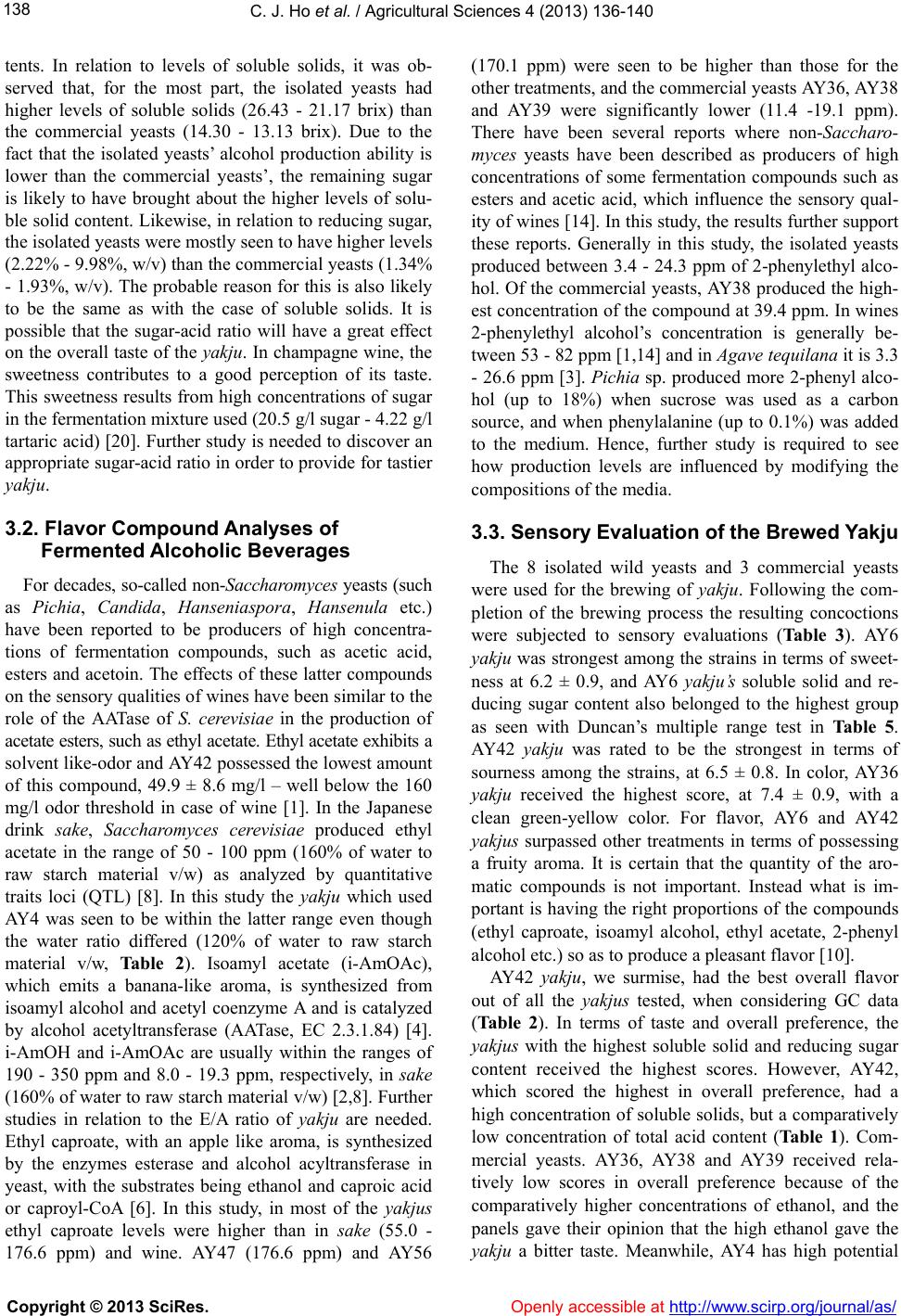
C. J. Ho et al. / Agricultural Sciences 4 (2013) 136-1 40
138
tents. In relation to levels of soluble solids, it was ob-
served that, for the most part, the isolated yeasts had
higher levels of soluble solids (26.43 - 21.17 brix) than
the commercial yeasts (14.30 - 13.13 brix). Due to the
fact that the isolated yeasts’ alcohol production ability is
lower than the commercial yeasts’, the remaining sugar
is likely to have brought about the higher levels of solu-
ble solid content. Likewise, in relation to reducing sugar,
the isolated yeasts were mostly seen to have higher levels
(2.22% - 9.98%, w/v) than the commercial yeasts (1.34%
- 1.93%, w/v). The probable reason for this is also likely
to be the same as with the case of soluble solids. It is
possible that the sugar-acid ratio will have a great effect
on the overall taste of the yakju. In champagne wine, the
sweetness contributes to a good perception of its taste.
This sweetness results from high concentrations of sugar
in the fermentation mixture used (20.5 g/l sugar - 4.22 g/l
tartaric acid) [20]. Further study is needed to discover an
appropriate sugar-acid ratio in order to provide for tastier
yakju.
3.2. Flavor Compound Analyses of
Fermented Alcoholic Beverages
For decades, so-called non-Saccharomyces yeasts (such
as Pichia, Candida , Hanseniaspora, Hansenula etc.)
have been reported to be producers of high concentra-
tions of fermentation compounds, such as acetic acid,
esters and acetoin. The effects of these latter compounds
on the sensory qualities of wines have been similar to the
role of the AATase of S. cerevisiae in the production of
acetate esters, such as ethyl acetate. Ethyl acetate exhibits a
solvent like-odor and AY42 possessed the lowest amount
of this compound, 49.9 ± 8.6 mg/l – well below the 160
mg/l odor threshold in case of wine [1]. In the Japanese
drink sake, Saccharomyces cerevisiae produced ethyl
acetate in the range of 50 - 100 ppm (160% of water to
raw starch material v/w) as analyzed by quantitative
traits loci (QTL) [8]. In this study the yakju which used
AY4 was seen to be within the latter range even though
the water ratio differed (120% of water to raw starch
material v/w, Table 2). Isoamyl acetate (i-AmOAc),
which emits a banana-like aroma, is synthesized from
isoamyl alcohol and acetyl coenzyme A and is catalyzed
by alcohol acetyltransferase (AATase, EC 2.3.1.84) [4].
i-AmOH and i-AmOAc are usually within the ranges of
190 - 350 ppm and 8.0 - 19.3 ppm, respectively, in sake
(160% of water to raw starch material v/w) [2,8]. Further
studies in relation to the E/A ratio of ya k ju are needed.
Ethyl caproate, with an apple like aroma, is synthesized
by the enzymes esterase and alcohol acyltransferase in
yeast, with the substrates being ethanol and caproic acid
or caproyl-CoA [6]. In this study, in most of the yakjus
ethyl caproate levels were higher than in sake (55.0 -
176.6 ppm) and wine. AY47 (176.6 ppm) and AY56
(170.1 ppm) were seen to be higher than those for the
other treatments, and the commercial yeasts AY36, AY38
and AY39 were significantly lower (11.4 -19.1 ppm).
There have been several reports where non-Saccharo-
myces yeasts have been described as producers of high
concentrations of some fermentation compounds such as
esters and acetic acid, which influence the sensory qual-
ity of wines [14]. In this study, the results further support
these reports. Generally in this study, the isolated yeasts
produced between 3.4 - 24.3 ppm of 2-phenylethyl alco-
hol. Of the commercial yeasts, AY38 produced the high-
est concentration of the compound at 39.4 ppm. In wines
2-phenylethyl alcohol’s concentration is generally be-
tween 53 - 82 ppm [1,14] and in Agave tequilana it is 3.3
- 26.6 ppm [3]. Pichia sp. produced more 2-phenyl alco-
hol (up to 18%) when sucrose was used as a carbon
source, and when phenylalanine (up to 0.1%) was added
to the medium. Hence, further study is required to see
how production levels are influenced by modifying the
compositions of the media.
3.3. Sensory Evaluation of the Brewed Yakju
The 8 isolated wild yeasts and 3 commercial yeasts
were used for the brewing of yakju. Following the com-
pletion of the brewing process the resulting concoctions
were subjected to sensory evaluations (Table 3). AY6
yakju was strongest among the strains in terms of sweet-
ness at 6.2 ± 0.9, and AY6 yakju’s soluble solid and re-
ducing sugar content also belonged to the highest group
as seen with Duncan’s multiple range test in Table 5.
AY42 yakju was rated to be the strongest in terms of
sourness among the strains, at 6.5 ± 0.8. In color, AY36
yakju received the highest score, at 7.4 ± 0.9, with a
clean green-yellow color. For flavor, AY6 and AY42
yakjus surpassed other treatments in terms of possessing
a fruity aroma. It is certain that the quantity of the aro-
matic compounds is not important. Instead what is im-
portant is having the right proportions of the compounds
(ethyl caproate, isoamyl alcohol, ethyl acetate, 2-phenyl
alcohol etc.) so as to produce a pleasant flavor [10].
AY42 yakj u , we surmise, had the best overall flavor
out of all the yakjus tested, when considering GC data
(Table 2). In terms of taste and overall preference, the
yakjus with the highest soluble solid and reducing sugar
content received the highest scores. However, AY42,
which scored the highest in overall preference, had a
high concentration of soluble solids, but a comparatively
low concentration of total acid content (Ta bl e 1 ). Com-
mercial yeasts. AY36, AY38 and AY39 received rela-
tively low scores in overall preference because of the
comparatively higher concentrations of ethanol, and the
panels gave their opinion that the high ethanol gave the
yakju a bitter taste. Meanwhile, AY4 has high potential
Copyright © 2013 SciRes. Openly accessible at http://www.scirp.org/journal/as/